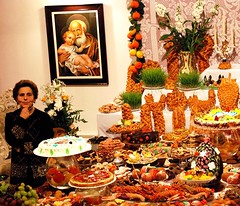"Laudato si', mi Signore, per sor'acqua, la quale è molto utile et hù mele et pretiosa et casta."
"We praise You, Lord, for Sister Water,
so useful, humble, precious and pure."
We take so many simple things for granted each day. A beautiful photo reminder.
Sunday, March 21, 2010
Tavola di San Giuseppe ~ Table of St Joseph
A beautiful photo of a St Joseph's festa table in Scoglitti, Sicilia. You can see the breads and the wonderful desserts. 'Padrona di casa', translates to the 'boss of the house'. Though Italy may be, at first glance, a macho culture, in reality mamma runs everything. She is often referred to also as 'la capa'.
The morning of the festa,the food and wine are blessed by the priest of the local parish. In years past, when the people of Sicily were very poor, they would only have bread to share with the poor. In modern times, with increased affluence, the feasts have become elaborate displays of the richness of the land, once dry and barren. You might look at this as the Italian version of the Thanksgiving celebration in the United States.
The morning of the festa,the food and wine are blessed by the priest of the local parish. In years past, when the people of Sicily were very poor, they would only have bread to share with the poor. In modern times, with increased affluence, the feasts have become elaborate displays of the richness of the land, once dry and barren. You might look at this as the Italian version of the Thanksgiving celebration in the United States.
Saturday, March 20, 2010
VIVA SAN GIUSEPPE!

Italy's people have a great love of many things: the arts, their history, and their customs and traditions. One tradition they hold especially dear is their devotion to their patron saints. Their homage to them include elaborate festas and incredible food.
The Festa di San Giuseppe is celebrated on March 19th, which is also Father's Day in Italy. (It seems appropriate that the Feast of St. Joseph is celebrated on this day in honor of fathers.)
Although traditionally it began in Sicily, the Feast of San Giuseppe is now celebrated throughout most of Italy. According to legend, during the Middle Ages a terrible drought and famine plagued the people of Sicily. It virtually destroyed most of their crops and many people in the western part of Sicily died of starvation. The people began praying to St. Joseph and begged for his intercession to their plight. In return they promised to celebrate his feast day by having special altars abundant in food that would be shared with all people rich and poor as their thanksgiving to him.
At midnight on March 19th the prayers of Sicily's children were answered. The rains came and the land which had been browned and barren were now lush and green again. Sicily's people has kept their promise to San Giuseppe through the generations by preparing elaborate food altars. In Sicily olive branches hung over doorways signify that a St. Joseph Altar is being held.)
Since the Festa di San Giuseppe is celebrated during the Lenten season the foods prepared do not contain meat. The main focus surrounds the variety, shapes and designs of breads made for this feast. There are three breads that honor the Holy Family. The bread for St. Joseph is in the shape of a staff. According to legend, the staff of St. Joseph bloomed with entwining flower blossoms which singled him out from Mary's other suitors as her husband-to-be. St. Joseph was a carpenter by trade and breadcrumbs signify sawdust.
The bread for Mary is in the shape of a date palm and a wreath with a star in the center represents Jesus. These three breads are placed upon an altar that has been created using the finest linens, and decorated with flowers (especially the St. Joseph Lily,) statues, candles and pictures. The staff bread of St. Joseph is placed on the left, the date palm bread of Mary is placed on the right, and the the wreath-star bread or a cross representing Jesus is placed in the middle.
The foods presented on the San Giuseppe table will include many different types of seafood (fried shrimp, calamari, fried baccala), vegetables of all kinds that will be either stuffed, fried, or parts of an omlette.) Speaking of omlettes...you will find some of the most scrumptious omelettes at a San Giuseppe table. Omlettes (frittatas) with vegetables like artichokes, cardoons (burdock), asparagus, broccoli, beans, potatoes, tomatoes, spinach and beans. Dried fava beans are a reminder of the great drought.
Desserts are also in great abundance. You will find a wide assortment of pastries, fruit, fritters, doughnuts and cakes on a St. Joseph Table. They are elegant and oh so good!!
There are a few famous saints that are celebrated here in the US, including St. Joseph. However, traditional Italians celebrate a saint every day of the year. If you are named after a saint, his or her day on the Catholic calendar is a second birthday of sorts for you, your ‘name day’ or onomastico(a) in Italian.
I grew up in a Roman Catholic family in a small town in New England, and I remember St. Joseph’s Day in particular because of the wonderful cream puffs that my grandmother made, which were also available in all of the village bakeries. In the southern states of the US, these are often referred to as Beignet (from the French). I’ll include some traditional recipes from the Feast of San Giuseppe in a future blog.

Buona festa di San Giuseppe ~ un po in ritardo!
Subscribe to:
Posts (Atom)



